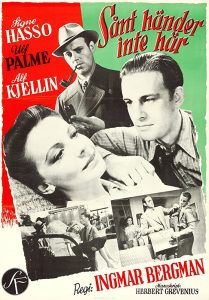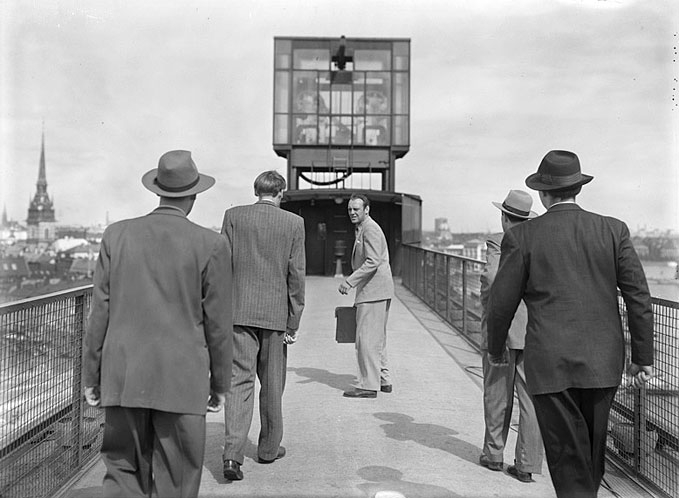
Director: Ingmar Bergman. Wrote: Herbert Grevenius. Cast: Signe Hasso, Alf Kjellen, Ulf Palme, Gösta Cederlund, Yngve Nordvall, Stig Olin, Ragnar Klange, Hanno Kompus, Sylvia Tael, Els Vaarman, Edmar Kuus, Rudolf Lipp. Spy drama / Sweden / 84′.
As the BFI’s ‘definitive’ three month Ingmar Bergman centenary season on the South Bank finally comes to its conclusion, one title directed by Bergman was as usual predictably conspicuous by its absence.
Sånt händer inte här, was an espionage thriller over which Bergman had no cast or script control, and to which he was precipitously assigned in the summer of 1950, only directing it because he needed the money. The only other of his own films Bergman rejected so emphatically was The Touch(1971), declaring in his memoirs that both “mark the very bottom of me”. By comparison with This Can’t Happen Here, however, the BFI has just re-released The Touch in a new restoration and given it an extended run on the South Bank.
Bergman has made far worse films than This Can’t Happen Here, and his antipathy towards this entertaining Cold War thriller probably owes more – like Hitchcock and Waltzes from Vienna – to the miserable time he had making it, which he described as a “nightmare”, rather than actually being the fault of the film itself. Having by his own account only just completed Summer Interlude, and admitting to being “dead tired”, he instead immediately had had to plunge straight into this elaborate production based on a 1944 novel, During Twelve Hours, by Waldemar Brøggero, also filmed in an English-language version and extensively shot on location in the Södermalm district of Stockholm by Bergman’s distinguished photographic collaborator Gunnar Fischer, with high profile stars (Signe Hasso and Alf Kjellin) recently returned from Hollywood. The shoot would have been arduous enough, but soon after production began, Bergman suffered a violent attack of influenza from which “arose sinus trouble that raged almost comically and tormented me throughout the rest of the filming”. (Signe Hasso was also ill during filming and it shows – she looks very gaunt).
Despite also being made in English, the film never opened in America, was only briefly released in Britain under the title High Tension in 1953 and was soon forgotten. A decent print of the film is however now available on YouTube, unfortunately without subtitles.
The promise offered by its opening pre-credits sequence, with a laconic opening narration spoken over a menacing Bergmanesque cloudy sky, is fulfilled with Ulf Palme as a memorably creepy villain and a former war criminal now attempting to defect to the West from a sinister foreign power called Liquidatzia. The name of the foreign power already suggests that someone’s tongue was in their cheek, and the fact than Bergman wasn’t taking any of this seriously anticipates the sometimes very black humour often found in later cold war thrillers such as North by North West and The Quiller Memorandum. The influence of Lang and Hitchcock are frequently evident, as well as the imagery later beloved of Melville (notably a dryly amusing sequence in which a gun keeps changing owner). Two memorably bizarre moments are the unmasking of a double agent behind a cinema screen from which the voices of Mickey Mouse and Goofy can be heard booming, and an eye-watering moment when a character evades his pursuers by leaping off a bridge, and instead of discreetly hitting the water or landing out of sight of the camera, excruciatingly crashes down on to a row of parked bicycles. RICHARD CHATTEN
There are rumours circulating that the Swedish Film Institute may finally lift its embargo with a showing at this year’s BFI LONDON FILM FESTIVAL 2018

 Director: Ingmar Bergman. Wrote: Herbert Grevenius. Cast: Signe Hasso, Alf Kjellen, Ulf Palme, Gösta Cederlund, Yngve Nordvall, Stig Olin, Ragnar Klange, Hanno Kompus, Sylvia Tael, Els Vaarman, Edmar Kuus, Rudolf Lipp. Spy drama / Sweden / 84′.
Director: Ingmar Bergman. Wrote: Herbert Grevenius. Cast: Signe Hasso, Alf Kjellen, Ulf Palme, Gösta Cederlund, Yngve Nordvall, Stig Olin, Ragnar Klange, Hanno Kompus, Sylvia Tael, Els Vaarman, Edmar Kuus, Rudolf Lipp. Spy drama / Sweden / 84′.